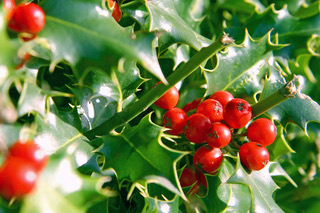Holly (Ilex aquifolium) is dioecious, meaning that individual trees/bushes can be male or female. The white flowers with four petals bloom on female species any time between early spring and the very beginning of summer, depending on the climate. When those flowers have been pollinated by insects they become red berries which stay on the female tree throughout the winter. Although you may see a Holly without any berries if the birds have feasted on them.

It is traditionally associated with the winter season and Christmas. When celebrating the birth of the Sun God, the Romans would present holly sprigs at their festival of Saturnalia. There is much superstition and folklore about Holly from offering protection and the spiky green leaves symbolising the tenacity and resilience of life.
The tree was seen as a fertility symbol and a charm against witches, goblins and the devil and bad luck was feared to fall on anyone who cut a Holly Tree down.
Often cemeteries have Holly bushes randomly dotted around the site, having self seeded from the berries on wreaths placed on graves at Christmas time.
Holly provides dense cover and good nesting opportunities for birds, while its deep, dry leaf litter may be used by hedgehogs and small mammals for hibernation.
Various moths and the caterpillars of the Holly Blue Butterfly eat the leaves and the smooth leaves which can be found at the top of the holly trees are popular with deer.
The dense cover with the protection of the spiky edged leaves are ideal for nesting birds as well small mammals, like wood mice, dormice and hedgehogs looking for an undisturbed place to hibernate. During the winter months when food sources may be scarce the berries on Holly are eaten by birds and small mammals.


